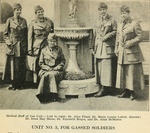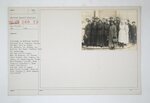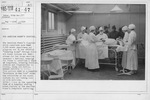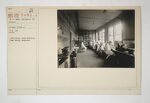Introduction
Until the passage of the Sparkman-Johnson Bill in 1943, the United States did not allow women physicians to become commissioned officers in any branch of the military. If women doctors wanted to serve in medical roles, they were forced to take positions as nurses or, eventually, contract surgeons, a position without rank or pay equal to that of commissioned officers. Many chose to avoid the US military altogether and instead volunteered as physicians with the Red Cross, the Women's Oversea Hospitals, the American Women's Hospitals Service, and others.
From the start of the conflict through today, mainstream accounts of World War I have overlooked women's participation, which makes reconstructing the experiences of women contract surgeons and volunteer physicians difficult but important work. This poster exhibit commemorates graduates of the Northwestern University Woman's Medical School who served during World War I, highlighting two physicians in particular: Adah McMahan, MD and Ruth Tunnicliff, MD.
This exhibit accompanied the exhibition American Women Physicians in World War I, which was on display at Galter Library from September to November 2020. Created by the American Medical Women's Association (AMWA), it tells the story of how women fought for the opportunity to serve as physicians during the war and it features the contributions of many individuals.
Credits
Curated and designed by Katie Lattal, MA, Special Collections Librarian.
At least 6 alumnae from Northwestern health sciences programs served in WWI. Because the US armed forces prohibited women physicians from joining its various medical corps, these women served as contract surgeons or joined women-run relief organizations. Those below attended the Northwestern University Woman’s Medical School because the Northwestern University Medical School—much like the Army—did not admit women at this time (except for Doherty, who attended the Dental School).
Ella Cleverdon, MD 1897
Contract Surgeon, Dispensary, Attending Surgeon’s Office, Washington, DC
Kate Doherty, DDS 1901
Dentist, Women’s Oversea Hospital, France
Julia M. Donahue, MD 1892
Contract Surgeon, Dispensary, Attending Surgeon’s Office, Washington, DC
Mary M.S. Johnstone, MD 1899
Contract Surgeon, Dispensary, Attending Surgeon’s Office, Washington, DC
Adah McMahan,* MD 1897
Physician, Women’s Oversea Hospital, France
Ruth Tunnicliff,* MD 1903 (Rush)
Contract Surgeon, Army Medical Corps, Camp Meade, MD
*McMahan and Tunnicliff are featured because information about their service was most accessible. Doherty’s service is also well-documented. Details on the service of Cleverdon, Donahue, and Johnstone were not readily available.
Adah McMahan, MD
 Education
Education
Class of 1897, Northwestern University Woman’s Medical School
War Service
Physician, Unit 3. August 1918 - April 1919.
Women’s Oversea Hospitals, USA, of the National American Woman Suffrage Assn.
Cempuis, France
Unit 3 was planned as a mobile unit that would provide initial treatment to soldiers gassed near the front. Trucks were specially designed and manufactured for them but did not arrive in France until after Armistice Day. Instead, Unit 3 was stationed at a gas base hospital near the Somme, relieving French doctors after a busy summer. They received their last cases—a group of men blinded by gas—on the night of the armistice.
Lorraine, France
After the armistice, Unit 3 operated a hospital and network of dispensaries in the Lorraine region, primarily serving refugees. McMahan and nurse Edyth Lacy headed the dispensary at Épinal-Vosges, making weekly trips to provide care throughout the surrounding villages. Unit 3 treated over 19,000 cases during their three month stay in Lorraine.
Ruth Tunnicliff, MD
 Education
Education
Class of 1903, Rush Medical College
*Tunnicliff attended Northwestern University Woman’s Medical School but the Trustees abruptly closed the school in 1902. She transferred to Rush and was part of the first graduating class to include women.
War Service
Contract Surgeon. Approximately July - November 1918. Base Hospital, Camp Meade, Army Medical Corps.
Chicago / Camp Pike, AR
Tunnicliff, a Chicago pathologist, developed the first measles immune serum in 1917. The next year the Army administered this serum to a group of soldiers stationed at Camp Pike to test its efficacy. Just days later, most of the test group was sent cross-country, rendering the experiment and full inoculation incomplete.
Camp Meade, MD
The Army contracted Tunnicliff in 1918 to continue the work of Capt. George Mather: developing vaccines for influenza and measles, diseases particularly pernicious among soldiers. Mather had died while studying the ongoing influenza and pneumonia epidemics at Camp Meade, succumbing to the very outbreak he was researching. Tunnicliff worked at the base hospital laboratory and published several papers detailing her findings.
Archival Sources
- 1903 Graduating Class. Rush Medical College Class Composites Collection (#4748), Rush University Medical Center Archives, Chicago, Ill. https://collections.carli.illinois.edu/digital/collection/rsh_classp/id/28/rec/1
- American Unofficial Collection of World War I Photographs, 1917-1918 (NAID 533461). Series in Records of the War Department General and Special Staffs, 1860-1952. Record Group 165, National Archives at College Park. https://catalog.archives.gov/id/533461
Published Sources
- "AMWA Exhibition: American Women Physicians in World War I." https://www.amwa-doc.org/wwi-exhibition/.
- Bellafaire, Judith, and Mercedes Herrera Graf. Women Doctors in War. Williams-Ford Texas A&M University Military History Series. College Station, TX: Texas A&M University Press, 2009.
- Donahue, Julia. "Fifty Years in Medicine (1892-1942)." Medical Woman’s Journal 52, no. 3 (March 1945): 43-44.
- "Dr. Adah Mcmahan Dies after Long and Successful Career." The Lafayette Journal and Courier, June 24, 1942. https://www.newspapers.com/article/25322696/adah-mcmahan/.
- Jensen, Kimberly. "Uncle Sam's Loyal Nieces: American Medical Women, Citizenship, and War Service in World War I." Bulletin of the History of Medicine 67, no. 4 (Winter 1993).
- The Medical Women's National Association. The Woman’s Medical Journal 27, no. 1-12 (Jan-Dec 1917). https://babel.hathitrust.org/cgi/pt?id=hvd.32044103011573&seq=1
- ———. The Woman’s Medical Journal 28, no. 1-12 (Jan-Dec 1918). https://babel.hathitrust.org/cgi/pt?id=hvd.32044103011565&seq=1
- Metcalfe, Raymond. "The Attending Surgeon’s Office, Washington, D.C.". Chap. 26 In The Surgeon General’s Office. The Medical Department of the United States Army in the World War Series. Washington, D.C.: Government Printing Office, 1921-29.
- Michie, Henry C., and George E. Lull. "Measles: Statistical Considerations Prior to the World War." Chap. 12 In Communicable and Other Diseases, edited by Joseph F. Siler. The Medical Department of the United States Army in the World War Series. Washington, DC: Government Printing Office, 1921-29.
- Morens, David M., and Jeffery K. Taubenberger. "A Forgotten Epidemic That Changed Medicine: Measles in the Us Army, 1917–18." The Lancet Infectious Diseases 15, no. 7 (2015). https://doi.org/10.1016/S1473-3099(15)00109-7.
- Morton, Rosalie Slaughter, Emily Dunning Barringer, Mary Merritt Crawford, Frances Cohen, Belle Thomas, and Sue Radcliff. Report of the American Women’s Hospitals. New York City, War Service Committee of the Medical Women’s National Association, 1917.
- Ruddock, Agnes Scholl. "Contract Surgeons: The Record of Agnes Scholl Ruddock." Medical Woman’s Journal 49, no. 2 (February 1942): 34-36.
- Smith, Avis E., Eliza H. Root, H. G. Cutler, and Marie J. Mergler. Woman's Medical School, Northwestern University: (Woman's Medical College of Chicago): The Institution and Its Founders: Class Histories, 1870-1896. Woman’s Medical College of Chicago. Chicago: H. G. Cutler, 1896.
- Women’s Oversea Hospitals, and the National American Woman Suffrage Association. Women's Oversea Hospitals, U.S.A.: Of the National American Woman Suffrage Association. New York, 1919.
Exhibit Details
Though women were not allowed to serve as physicians in the US military during World War I, they joined and established organizations that would put their medical expertise to use, often providing routine healthcare for local French and refugee communities in addition to treating Allied soldiers.
-
- Location
- Eckenhoff Reading Room
- Date
- Sep 1, 2020 - Nov 30, 2020
- Contact
- ghsl-specialcollections@northwestern.edu
- Links
- AMWA Exhibition - American Women Physicians in World War I
- Watch the film - At Home and Over There: American Women Physicians in World War I
- Subjects
- northwestern
- women's history
- military medicine
- world war i





.jpeg)

